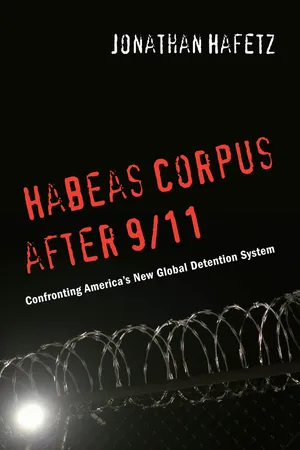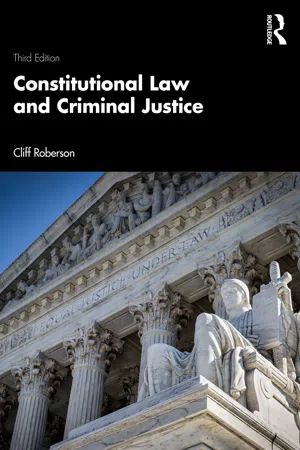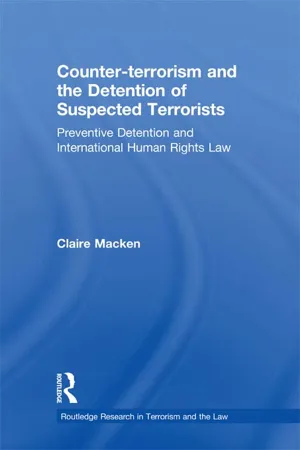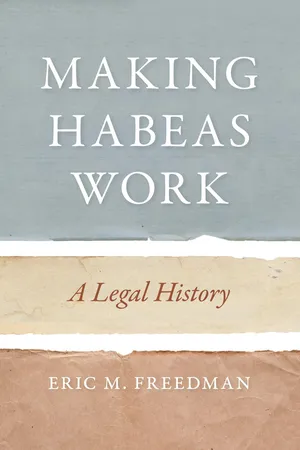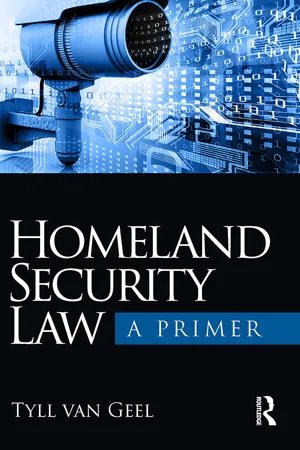History
Habeas Corpus Suspension Act2
The Habeas Corpus Suspension Act of 1863 was a U.S. federal law that allowed the President to suspend the right of habeas corpus during the American Civil War. This meant that individuals could be imprisoned without being charged or brought before a court. The Act was controversial and raised concerns about civil liberties and the balance of power between the branches of government.
Written by Perlego with AI-assistance
Related key terms
Related key terms
1 of 4
Related key terms
1 of 3
10 Key excerpts on "Habeas Corpus Suspension Act2"
- eBook - ePub
Habeas Corpus after 9/11
Confronting America's New Global Detention System
- Jonathan Hafetz(Author)
- 2011(Publication Date)
- NYU Press(Publisher)
12Even so, there remained one lawful means to deprive prisoners of the Great Writ’s protections: suspension of habeas corpus by Parliament. Through suspension acts, Parliament deprived courts of their authority to adjudicate accusations by Crown officials and asserted its control over detention in matters affecting the security of the state.13 In 1688, Parliament passed the first suspension act amid armed conflict abroad and fears that King James II would try to regain the throne after his ouster earlier that year in the Glorious Revolution.14 Other suspension acts followed, authorizing the detention of suspected enemies of state without judicial inquiry.15 The acts did not suspend habeas corpus itself, however, but the right secured by the writ to test the government’s allegations in court.16 Suspension acts generally contained an expiration date, which was usually a year or less from the time of their passage.17 Prisoners also could still seek judicial review of whether they fell within the parameters of the given suspension legislation.18 So, while suspending habeas corpus gave “extreme powers . . . to the executive,” those powers were specifically bound by the emergency that necessitated them and remained “distinctly limited by law.”19Unless suspended, habeas corpus has traditionally been available to all prisoners in the custody of the Crown, and its protections have been invoked by common thieves and alleged enemies of state alike. Access to habeas corpus did not turn on where a prisoner had been born or his nationality.20 Indeed, one of the most celebrated habeas cases of the eighteenth century involved a slave who had been purchased in Virginia and detained briefly in England while awaiting voyage to Jamaica. The court granted the writ and ordered the slave released because slavery was not legal in England.21 In another case involving two men held as “alien enemies and spies,” the court not only rejected the government’s argument that the prisoners’ status as foreigners disqualified them from the benefits of habeas corpus but also ordered them discharged.22 The question in a habeas corpus proceeding was whether the individual was properly within the Crown’s detention authority, not whether he was a subject in the modern sense of citizenship.23 Or put another way, the focus was less on the rights of the prisoner than on the wrongs committed by the jailer.24 - eBook - ePub
The Constitutional Value of Sunset Clauses
An historical and normative analysis
- Antonios Kouroutakis(Author)
- 2016(Publication Date)
- Routledge(Publisher)
113 For further details see Amanda L. Tyler, ‘The Forgotten Core Meaning of the Suspension Clause’ (2012) 125 Harvard Law Review 901, 934.114 Journal of the House of Lords 1685–1691 Vol XIV (1767–1830) 222.115 For more discussion about the Habeas Corpus Suspension Acts see Chrs 4 and 8.116 The Convention Parliament (William): The convention becomes a Parliament – begins 20/2/1689’, The History and Proceedings of the House of Commons 1680–1695 Vol 2 (1742) 280.117 1 Gul&Mar c 5 [An Act for Impowering His Majestie to Apprehend and Detaine such Persons as He shall finde just Cause to Suspect are Conspireing against the Government]; 1 Gul&Mar. c 19 [An Act for Impowering His Majestie to Commit without Baile such Persons as He shall finde just Cause to Suspect are Conspireing against the Government].118 Mark A Thomson, A Constitutional History of England 1642–1801 (Methuen 1938) 286.119 - eBook - ePub
- Cliff Roberson(Author)
- 2021(Publication Date)
- Routledge(Publisher)
Surviving accounts of the ratification debates provide additional evidence that the Framers deemed the writ to be an essential mechanism in the separation-of-powers scheme. In a critical exchange with Patrick Henry at the Virginia ratifying convention Edmund Randolph referred to the Suspension Clause as an “exception” to the “power given to Congress to regulate courts.” A resolution passed by the New York ratifying convention made clear its understanding that the Clause not only protects against arbitrary suspensions of the writ but also guarantees an affirmative right to judicial inquiry into the causes of detention. Alexander Hamilton (1787) likewise explained that by providing the detainee a judicial forum to challenge detention, the writ preserves limited government.As Hamilton explained in The Federalist No. 84; the practice of arbitrary imprisonments has been, in all ages, the favorite and most formidable instruments of tyranny. The observations of the judicious Blackstone are well worthy of recital: To bereave a man of life or by violence to confiscate his estate, without accusation or trial, would be so gross and notorious an act of despotism as must at once convey the alarm of tyranny throughout the whole nation; but confinement of the person, by secretly hurrying him to jail, where his sufferings are unknown or forgotten, is a less public, a less striking, and therefore a more dangerous engine of arbitrary government. And as a remedy for this fatal evil he is everywhere peculiarly emphatical in his encomiums on the habeas corpus act, which in one place he calls the BULWARK of the British Constitution.Post-1789 habeas developments in England, though not bearing upon the Framers’ intent, do verify their foresight. Those later events would underscore the need for structural barriers against arbitrary suspensions of the writ. Just as the writ had been vulnerable to executive and parliamentary encroachment on both sides of the Atlantic before the American Revolution, despite the Habeas Corpus Act of 1679, the writ was suspended with frequency in England during times of political unrest after 1789. Parliament suspended the writ for much of the period from 1792 to 1801, resulting in rampant arbitrary imprisonment.In our own system the Suspension Clause is designed to protect against these cyclical abuses. The Clause protects the rights of the detained by a means consistent with the essential design of the Constitution. It ensures that, except during periods of formal suspension, the Judiciary will have a time-tested device, the writ, to maintain the delicate balance of governance that is itself the surest safeguard of liberty. The Clause protects the rights of the detained by affirming the duty and authority of the Judiciary to call the jailer to account. The essence of habeas corpus is an attack by a person in custody upon the legality of that custody. The important fact to be observed in regard to the mode of procedure upon this habeas writ is, that it is directed to, and served upon, not the person confined, but his jailer. The separation-of-powers doctrine, and the history that influenced its design, therefore must inform the reach and purpose of the Suspension Clause. - eBook - ePub
Habeas for the Twenty-First Century
Uses, Abuses, and the Future of the Great Writ
- Nancy J. King, Joseph L. Hoffmann(Authors)
- 2011(Publication Date)
- University of Chicago Press(Publisher)
In this sense, the writ of habeas corpus is, in the Court’s words, “an indispensable mechanism for monitoring the separation of powers.” 6 Recognizing this integral relationship between instability in the governmental balance of powers brought on by political or social crisis and the necessity for habeas corpus review, the Framers acknowledged that “pendular swings to and away from individual liberty were endemic to undivided, controlled power.” They knew that in England, denial or suspension of the writ “occurred in times of political unrest, to the anguish of the imprisoned and the outrage of those in sympathy with them.” They designed the Suspension Clause precisely “to protect against these cyclical abuses.” 7 It is this institutional justification for habeas review, not its ability to correct individual injustices, that warranted placing habeas among the other structural constraints on federal power in the Constitution itself. And it is this justification for habeas review that must, in the future, continue to guide habeas policy. In sum, the Court’s repeated recognition that “the need for habeas corpus is more urgent” whenever a person is detained without conviction has two rationales, both of which we develop in this chapter. 8 First, detention without conviction lacks the procedural safeguards that in criminal cases help to protect against errors in the decision to confine, including the participation of an impartial judge and jury. Habeas is a crucial safety net that is available to such a prisoner when other alternatives for judicial review have yet to take shape. Second, and more importantly, by helping to ensure that federal power remains divided between the political branches and the independent judiciary, habeas serves as a vital structural protection for democracy and the rule of law during times of unrest - eBook - ePub
Counter-terrorism and the Detention of Suspected Terrorists
Preventive Detention and International Human Rights Law
- Claire Macken(Author)
- 2013(Publication Date)
- Routledge(Publisher)
27The meaning of a ‘state of emergency’ was perhaps first analysed by Aristotle, referred to as Aesymnetes (or aesymneteia), a practice in ancient Greek cities.28 Emergency powers were recognised and used in English martial law between 1300 and 1628, and in France, a state of siege was declared in 1791 as a consequence of the 1789 French Revolution.29 In English legal history, the first suspension of the Habeas Corpus Acts by Parliament happened amid armed conflict abroad and fears that the exiled King James II would try to regain his throne after the Revolution of 1688.30 The 1688 Act, however, did not give the Executive a general power to arrest and detain a person thought to be dangerous.31The United Kingdom Executive was vested with extraordinary powers of arrest and detention, including the suspension of habeas corpus, by an Act in 1696 in due course.32 The Act gave six Privy Council members the power to imprison persons suspected of high treason or treasonable practices without trial or mainprize.33 The Act suspended habeas corpus for a limited time after which the right to review the lawfulness of detention was allowed.34 This became the practice, and early examples cited by Simpson in his study include The Protection of Life and Property (Ireland) Act of 1871 (the ‘Westmeath Act’).35 This Act empowered the Executive to detain persons suspected of being members of the Ribbon society in the County of Westmeath.36 The early sixteenth-century Habeas Corpus Suspension Acts in 1688 and 1696 served as the model for the implementation of emergency powers until the nineteenth and twentieth centuries, and the development of international human rights law.37 This developed in parallel with the emergence of human rights at a regional level, including the French Declaration of the Rights of Man and the Citizen of 1789,38 - eBook - ePub
Silencing the Opposition
How the U.S. Government Suppressed Freedom of Expression During Major Crises, Second Edition
- Craig R. Smith, Craig R. Smith(Authors)
- 2011(Publication Date)
- SUNY Press(Publisher)
Chapter 2 Lincoln and Habeas CorpusCraig R. Smith and Stephanie J. HurstT he purpose of this chapter is to explore ways in which the Lincoln Administration suppressed certain freedoms during the Civil War.1 This was a time when many tensions developed and civilians demanded protection from arbitrary arrest and the right to protest the conduct of the war. These demands ran headlong into the suspension of habeas corpus,2 which the government often deemed necessary to keep the peace and to protect it's military operations. At the same time, the president was often conflicted by these competing claims. His anxiety was expressed in letters to friends and in his reluctance to apply the full powers of the presidency on behalf of suppression. Lincoln recognized that an individual's protection from arbitrary arrest is closely tied to his or her right to free speech. He knew that the suspension of habeas corpus made it easier to enforce restrictions. And he knew that the court of jurisdiction plays a large part in determining how and what expression will be curtailed. Military tribunals tend to be much more severe than civilian tribunals. Thus, tension would be exacerbated by jurisdictional disputes throughout this crisis. We hope by this juncture that the reader understands that Lincoln's dilemma is not some remote, isolated moment in American jurisprudence. It is a moment that recurs and one that we are facing at the time of this writing. (See chapter 10 in this book.)The Road to Abolition
However, before we can understand the dilemma facing Lincoln, we need to understand how it evolved. The call for abolition was an outgrowth of the second great religious awakening in America. Perhaps the most influential of the moralists was William Lloyd Garrison, whose attack on slavery was so strident that it often led to violence. His first attack came on January 1, 1831, from Boston, when he was only 26 and writing in The Liberator - eBook - ePub
Making Habeas Work
A Legal History
- Eric M. Freedman(Author)
- 2018(Publication Date)
- NYU Press(Publisher)
16After presenting an historical account of habeas steeped in the “duty and authority of the Judiciary to call the jailer to account,”17 Boumediene determined that “the judicial authority to consider petitions for habeas corpus relief” derives from principles “of separation of powers.”18 (Of course, as the context makes clear, the Court is here using the phrase “separation of powers” in the sense that I assigned in chapter 11 above to “checks and balances.”)The judiciary has the habeas power of inquiry and remedy19 (including ordering release)20 needed to effectively play its role in policing the other branches.21 As Boumediene makes clear, this is true regardless of whether Congress has (1) passed a statute restricting the power (the actual situation in Boumediene), or (2) failed to pass one granting the power (the hypothetical posed by Bollman).- (1) The issue actually before the Court arose under the Suspension Clause, a restriction on congressional authority to pass a statute like the MCA. That is why the Court explicitly grounded its holding invalidating the act in the Suspension Clause.22
- (2) But the broader proposition—the modern dicta supporting an inherent judicial habeas power which destroyed the older dicta rejecting it—does not originate in the Suspension Clause, which is a limit on the powers of Congress. That proposition rests on Article III, which affirmatively declares, “The judicial power of the United States shall be vested in one supreme Court, and in such inferior Courts as the Congress may from time to time ordain and establish.”23
- eBook - ePub
Abraham Lincoln and Treason in the Civil War
The Trials of John Merryman
- Jonathan W. White(Author)
- 2011(Publication Date)
- LSU Press(Publisher)
THE GOVERNMENT MUST IN SOME WAY SUSTAIN YOU IN YOUR OFFICIAL ACTS ” The Habeas Corpus Act, Part II: The Failure of Congress to Protect Those Waging WarT he military arrest and trial of civilians was only one part of the habeas corpus problem that arose during the Civil War. Prior to the passage of the Habeas Corpus Act in March 1863, military officers and government officials who participated in the arrest of civilians were vulnerable to civil prosecution in civil courts for their actions in defense of the Union. These lawsuits struck fear in the hearts of Union commanders. Indeed, one Pennsylvania Supreme Court justice believed that “[i]ndemnity for the past is necessary to prevent many innocent men from being harassed and ruined.”1 Moreover, such suits allowed disloyal Americans to use the state and federal judiciaries to undermine the Union war effort. High Union officials understood the damage that these suits could cause. As a consequence, they pressed Congress to pass indemnifying legislation.2 The result, however, was disappointing. The Habeas Corpus Act, or Indemnity Act, of 1863 did little to protect Union officials, and damages suits continued to plague Union authorities during the second half of the war. So threatening were suits of this nature, and so weak was the protection offered by Congress, that Union leaders were forced to take drastic measures to protect themselves against their “disloyal” adversaries. One powerful figure, for example, recommended re-arresting Maryland civilians who were suing him for wrongful arrest so that they could no longer prosecute their suits against him. In the absence of adequate congressional protection, those waging war on behalf of the Union had to devise their own methods for saving themselves from disloyal civilians within the loyal states.Suspected traitors in the North began filing lawsuits against Union officials very early in the war. Baltimore police commissioner Charles Howard, for example, sued a military officer in August 1861 for illegal search and seizure. Other Baltimoreans sued General John E. Wool for damages from the time they were held in his custody at Fortress Monroe.3 In April 1862, Philadelphia resident Pierce Butler sued former Secretary of War Simon Cameron for trespass, assault and battery, and false imprisonment. The matter, which originated in the Pennsylvania state court system, never went to trial, but Cameron was not taking any chances. Cameron sent word of the suit to the president. He also wrote to General George Cadwalader asking him to “disabus[e] the mind of your brother of prejudices against me.” General Cadwalader’s brother, John, was the U.S. district judge in Philadelphia. The general responded that the “Govt. must in some way sustain” Union authorities in their “Official acts.” “I am myself vulnerable and liable to be harassed by Merryman & others in Baltimore,” he continued. “I will no doubt be arrested the next time I go to Maryland which I should regret at this moment.” Cadwalader’s fears were not overstated. Indeed, Philadelphia lawyer Benjamin H. Brewster noted that Cadwalader “dreads the Merriman case.”4 - eBook - ePub
Homeland Security Law
A Primer
- Tyll van Geel(Author)
- 2018(Publication Date)
- Routledge(Publisher)
5 ]I. The writ of habeas corpus: backgroundThe writ of habeas corpus predated the Constitution. The Suspension Clause of the Constitution presumes the existence of habeas corpus by prohibiting its suspension “unless when in Cases of Rebellion or Invasion the public safety may require it.”6 Since 1789 habeas corpus practice has been a result of federal legislation.7 Statutes specify who may seek the writ, what burden of proof the government must satisfy to the justify the detention, the hearing procedures, and the relief that may be granted. Section 2241 specifies that the writ will not be issued unless the detainee “is in custody in violation of the Constitution or laws or treaties of the United States.”8 The Supreme Court has said that the writ was vital for securing freedom from unlawful restraint, and as such was specifically provided for in the Constitution.9An application for a writ must satisfy various statutory requirements that vary depending whether the petitioner is held in custody by federal or state officials.10 One requirement that has loomed up in cases involving the detainment of alleged enemy belligerents is that the writ must be directed to the person who has custody of the petitioner. This requirement blocked the use of a writ filed by Jose Padilla in a New York district court when it was directed to the Secretary of Defense, instead of to the commander of the brig in South Carolina where Padilla was being held. Because the brig commander was in South Carolina, the New York district court did not have jurisdiction to entertain the petition.11 - eBook - ePub
The Constitution of the United States of America
Analysis and Interpretation
- (Author)
- 2006(Publication Date)
- Perlego(Publisher)
[437]On the specific matter of property seizures, Justice Frankfurter's concurring opinion in the Youngstown Case is accompanied by appendices containing a synoptic analysis of legislation authorizing seizures of industrial property and also a summary of seizures of industrial plants and facilities by Presidents without definite statutory warrant. Eighteen such statutes are listed, all but the first of which were enacted between 1916 and 1951. Of presidential seizures unsupported by reference to specific statutory authorization, he lists eight as occurring during World War I. To justify these it was deemed sufficient to refer to "the Constitution and laws" generally. For the World War II period he lists eleven seizures in justification of which no statutory authority was cited. The first of these was the seizure of the North American Aviation, Inc., of Englewood, California. In support of this action Attorney General Jackson, as Chief Justice Vinson points out in his dissenting opinion, "vigorously proclaimed that the President had the moral duty to keep this nation's defense effort a 'going concern.'"[438] Said the then Attorney General, "The Presidential proclamation rests upon the aggregate of the Presidential powers derived from the Constitution itself and from statutes enacted by the Congress. The Constitution lays upon the President the duty 'to take care that the laws be faithfully executed.' Among the laws which he is required to find means to execute are those which direct him to equip an enlarged army, to provide for a strengthened navy, to protect Government property, to protect those who are engaged in carrying out the business of the Government, and to carry out the provisions of the Lend-Lease Act. For the faithful execution of such laws the President has back of him not only each general law-enforcement power conferred by the various acts of Congress but the aggregate of all such laws plus that wide discretion as to method vested in him by the Constitution for the purpose of executing the laws."[439] In the War Labor Disputes Act of June 25, 1943,[440] such seizures were put on a statutory basis. As the Chief Justice points out, the purpose of this measure, as stated by its sponsor, was not to augment presidential power but to "let the country know that the Congress is squarely behind the President."[441]
Index pages curate the most relevant extracts from our library of academic textbooks. They’ve been created using an in-house natural language model (NLM), each adding context and meaning to key research topics.
Explore more topic indexes
Explore more topic indexes
1 of 6
Explore more topic indexes
1 of 4
